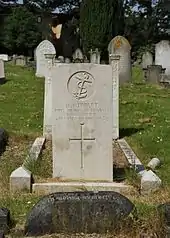HMS Lennox (1914)
HMS Lennox was a Laforey-class destroyer built for the Royal Navy during the 1910s.
| History | |
|---|---|
| Name: | HMS Lennox |
| Builder: | William Beardmore and Company |
| Launched: | 2 March 1914 |
| Fate: | Sold and broken up October 1921 |
| General characteristics | |
| Class and type: | Laforey-class destroyer |
| Displacement: | 965–1,010 long tons (980–1,026 t) |
| Length: | 268 ft 10 in (81.94 m) o/a |
| Beam: | 27 ft 8 in (8.43 m) |
| Draught: | 10 ft 6 in (3.20 m) |
| Installed power: |
|
| Propulsion: | 2 Shafts; 2 steam turbines |
| Speed: | 29 knots (54 km/h; 33 mph) |
| Range: | 1,720 nmi (3,190 km; 1,980 mi) at 15 knots (28 km/h; 17 mph) |
| Complement: | 74 |
| Armament: |
|
Description
The Laforey class were improved and faster versions of the preceding Acasta class.[1] They displaced 965–1,010 long tons (980–1,026 t). The ships had an overall length of 268 feet 10 inches (81.9 m), a beam of 27 feet 8 inches (8.4 m) and a draught of 10 feet 6 inches (3.2 m). Lennox was powered by two Parsons direct-drive steam turbines, each driving one propeller shaft, using steam provided by four Yarrow boilers.[2] The turbines developed a total of 24,500 shaft horsepower (18,300 kW) and gave a maximum speed of 29 knots (54 km/h; 33 mph). The ships carried a maximum of 280 long tons (280 t) of fuel oil that gave them a range of 1,750 nautical miles (3,240 km; 2,010 mi) at 15 knots (28 km/h; 17 mph). The ships' complement was 74 officers and ratings.[3]
The ships were armed with three single QF 4-inch (102 mm) Mark IV guns and two QF 1.5-pounder (37 mm) anti-aircraft guns. These latter guns were later replaced by a pair of QF 2-pounder (40 mm) "pom-pom" anti-aircraft guns. The ships were also fitted with two above-water twin mounts for 21-inch (533 mm) torpedoes. They were equipped with rails to carry four Vickers Elia Mk IV mines, although these rails were never used.[3]
Construction and service

Lennox was laid down at William Beardmore and Company's Clydebank shipyard as Portia on 14 November 1912.[4] On 30 September 1913, the Admiralty ordered that the L-class be renamed with names beginning with the letter "L", and Portia was renamed Lennox.[2] She was launched on 17 March 1914 on completed in July that year.[4]
On commissioning, Lennox joined the 3rd Destroyer Flotilla, based at The Nore.[5][6] On the outbreak of the First World War this Flotilla became part of the Harwich Force, under the overall command of Commodore Reginald Tyrwhitt,[6] serving in the North Sea, but capable of reinforcing either the Grand Fleet or forces in the English Channel as required.[7] Lennox saw action in several engagements, including the Battle off Texel. On 6 May 1916, Lennox accidentally collided with HMS Ben-my-Chree, a seaplane carrier. Damage was insignificant for both ships, however.[8]
Notes
- Friedman, p. 129
- Gardiner & Gray, p. 76
- Friedman, p. 296
- Friedman, p. 307.
- "Naval Matters—Past and Prospective: Sheerness Dockyard". The Marine Engineer and Naval Architect. Vol. 37 no. 443. August 1914. p. 7.
- Manning, p. 15.
- Friedman, pp. 139–140.
- Caruna, "et al"
Bibliography
- Caruana, J.; Field, Andy; Head, Michael; et al. (December 2012). "Question 33/48: British Seaplane Tender Sunk by Turkish Artillery". Warship International. Vol. 49 no. 4. Toledo, Ohio: International Naval Research Organization. pp. 297–99. ISSN 0043-0374.
- Colledge, J. J.; Warlow, Ben (2006) [1969]. Ships of the Royal Navy: The Complete Record of all Fighting Ships of the Royal Navy (Rev. ed.). London: Chatham Publishing. ISBN 978-1-86176-281-8.
- Dittmar, F.J. & Colledge, J.J. (1972). British Warships 1914–1919. Shepperton, UK: Ian Allan. ISBN 0-7110-0380-7.
- Friedman, Norman (2009). British Destroyers: From Earliest Days to the Second World War. Barnsley, UK: Seaforth Publishing. ISBN 978-1-84832-049-9.
- Gardiner, Robert & Gray, Randal (1985). Conway's All The World's Fighting Ships 1906–1921. London: Conway Maritime Press. ISBN 0-85177-245-5.
- Manning, T. D. (1961). The British Destroyer. London: Putnam.
- Massie, Robert K. (2007). Castles of Steel: Britain, Germany and the Winning of the War at Sea. London: Vintage Books. ISBN 978-0-099-52378-9.
- Monograph No. 6: The Passage of the British Expeditionary Force, August, 1914 (PDF). Naval Staff Monographs (Historical). III. Naval Staff, Training and Staff Duties Division. 1921. pp. 1–70.
- Monograph No. 11: The Battle of the Heligoland Bight, August 28th, 1914 (PDF). Naval Staff Monographs (Historical). III. Naval Staff, Training and Staff Duties Division. 1921. pp. 108–166.
